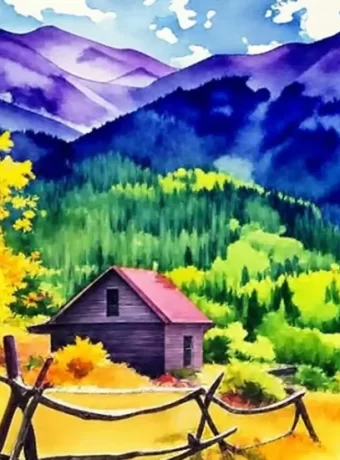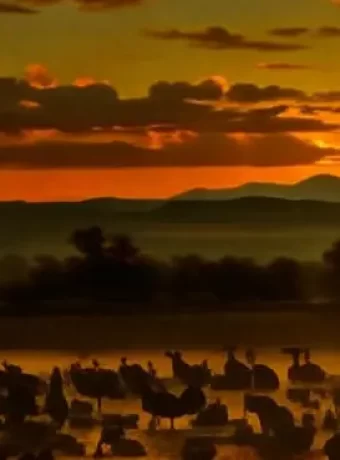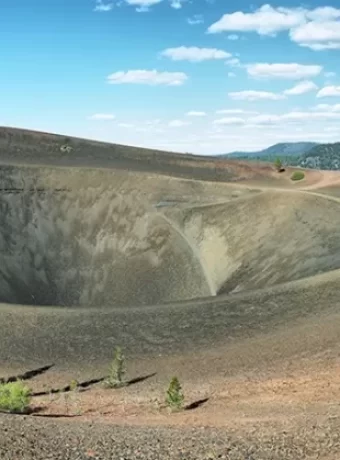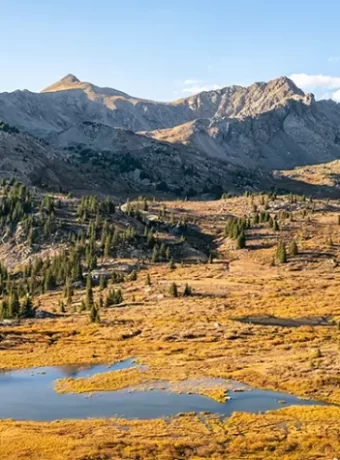DIY Fly Fishing Colorado River Headwaters to Grand Junction Colorado
Embarking on a journey along the mighty Colorado River offers more than just scenic vistas; it’s a paradise for anglers aiming for that perfect catch. Starting from its unassuming origins in Rocky Mountain National Park and flowing down to the lively currents close to Grand Junction, the river emerges as a sanctuary for enthusiasts engrossed in the art of fly fishing. Whether you’re drawn by the allure of catching rainbow trout or you’re eager to navigate through Gold Medal Waters, doing it yourself (DIY) adds an unmatched layer of satisfaction.
The quest isn’t just about landing fish; it’s about immersing oneself in nature’s grandeur while testing skills against some of the most sought-after trout populations in America. So why would someone like me dive into DIY fly fishing along this iconic river? It’s simple – when adventure calls with such promise, hesitation is no option.
Table Of Contents:
- Unveiling the Colorado River: An Overview
- Best Fly Fishing Spots along the Colorado River
- Essential Gear for Fly Fishing in Colorado
- Decoding Fly Types for Successful Catch
- Fly Fishing Regulations in Colorado
- Planning Your Fly Fishing Trip
- FAQs in Relation to DIY Fly Fishing Colorado River Headwaters to Grand Junction Colorado
- Conclusion of Fly Fishing Colorado River Colorado
- From Colorado to Alaska and back to Montana
Unveiling the Colorado River: An Overview
The Colorado River is a force of nature that’s been carving its way through the American Southwest for millions of years.
It’s a river that’s seen it all – from the rise and fall of ancient civilizations to the boom and bust of the American West.
Exploring the Colorado River’s Course
The Colorado River starts its journey high up in the Rocky Mountains of Colorado, where it’s fed by melting snow and alpine springs. Beginning above Lulu City, what’s left of a silver mining town in Rocky Mountain National Park.
From there, it flows southwest through some of the most iconic landscapes in the American West, including the Grand Canyon, before emptying into the Gulf of California in Mexico.
Along the way, the river passes through seven U.S. states and two Mexican states, covering a distance of over 1,450 miles.
It’s a journey that takes the river through a diverse range of ecosystems, from the high-altitude forests of the Rockies to the arid deserts of the Southwest.
The Colorado River is also a vital source of water for the region, providing drinking water for over 40 million people and irrigating over 5 million acres of farmland.
In fact, the river is so important to the region that it’s often referred to as the “lifeblood of the Southwest.”
But the Colorado River is more than just a source of water – it’s also a recreational paradise for outdoor enthusiasts.
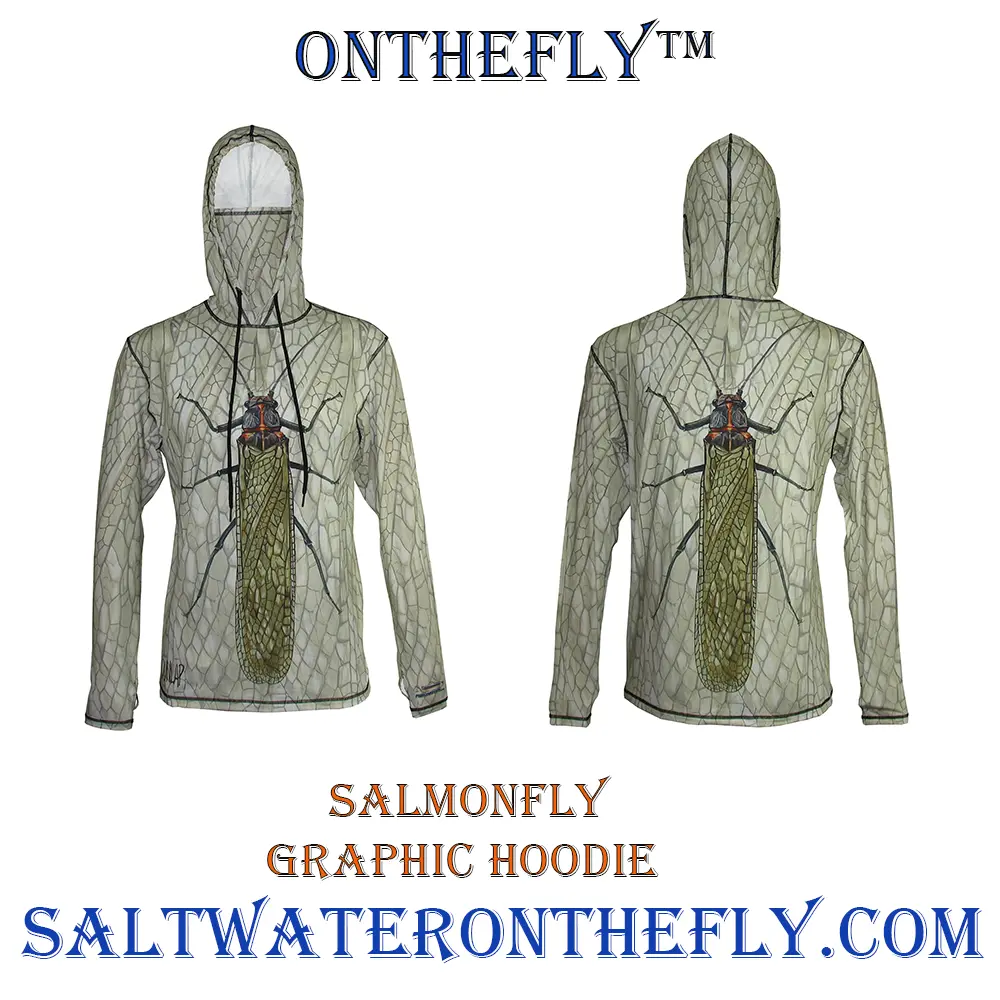
Wearing sun protective outdoor apparel is a must fly fishing and hiking through out the Rocky Mountains. Salmonfly Graphic Hoodie is a great out and base layer. UPF-50 sun protection.
The river is home to some of the best whitewater rafting in the world, with rapids ranging from mild to wild.
And for those who prefer a more leisurely pace, the river offers plenty of opportunities for fishing, kayaking, and stand-up paddleboarding.
One of the most popular spots along the Colorado River is Glenwood Springs, a charming mountain town known for its hot springs and world-class fly fishing.
Nestled on the river’s edge, this town serves as an ideal launchpad for delving into the vast wilds that lie beyond.
From Glenwood Springs, anglers can easily access some of the best fly fishing spots on the Colorado River, including the famous “Miracle Mile” stretch just downstream from the town.
Understanding the River’s Ecosystem
But the Colorado River is more than just a playground for humans – it’s also home to a diverse array of wildlife.
Over thirty indigenous fish species thrive in the river’s embrace, among them the imperiled Colorado pikeminnow and the formidable razorback sucker.
And along the river’s banks, you’ll find everything from bighorn sheep to bald eagles to black bears.
Yet, this vital artery’s existence is jeopardized by a multitude of challenges such as shifting climates, excessive exploitation, and contamination.
In recent years, the river has been hit hard by drought, with water levels dropping to historic lows.
The ensuing skirmishes among states dependent on the river’s flow, juxtaposed with the tug-of-war between conservation advocates and expansionists, are a direct outcome of these predicaments.
But despite these challenges, the Colorado River remains one of the most iconic and beloved waterways in the American West.
Amidst the ongoing tug-of-war for its waters, and despite the frictions it ignites among states and between nature advocates and builders, this river remains a pivotal force in sculpting both the past and future cultural landscapes of its surrounding territories.
So whether you’re a seasoned angler looking for your next big catch, or just someone who appreciates the beauty and power of nature, the Colorado River is a destination that should be on your bucket list.
Just remember to respect the river and all the life it supports, and to do your part to help protect this incredible resource for future generations.
Best Fly Fishing Spots along the Colorado River
If you’re an angler looking for the ultimate fly fishing experience, look no further than the Colorado River.
This iconic waterway is home to some of the best trout fishing in the world, with miles of pristine water and stunning scenery to boot.
Top Fishing Locations from Headwaters to Grand Junction
One of the best places to start your Colorado River fly fishing adventure is at the headwaters in Rocky Mountain National Park. Just above the ghost town of Lulu City. Beautiful area with several trail junctions and 1 weight fly fishing for small brook trout and cutthroat.
Here, you’ll find crystal-clear streams and high-altitude lakes teeming with native cutthroat trout.
As you move downstream, the river picks up steam and enters a series of deep canyons and rugged wilderness areas.
This is where you’ll find some of the best fishing on the entire river, with trophy-sized rainbow and brown trout lurking in the deep pools and fast-moving rapids.
One of the most famous stretches of the Colorado River for fly fishing is the “Miracle Mile” near Glenwood Springs.
At this part of the river, stoneflies and caddisflies hatch in abundance, sparking a voracious feast among the trout as they break the water’s surface.
Further downstream, near the town of Kremmling, you’ll find another world-class fishery in the form of the Blue River.
This tributary of the Colorado is home to some of the biggest and most beautiful trout in the state, with fish over 20 inches not uncommon.
As you continue your journey west, you’ll eventually reach the city of Grand Junction, where the Colorado River meets the Gunnison River.
This confluence creates a unique ecosystem that supports a wide variety of fish species, including bass, carp, and catfish in addition to trout.
Access Points and Boat Launches
Of course, to access all these incredible fishing spots, you’ll need to know where to go and how to get there.
Fortunately, the Colorado River is well-served by a network of access points and boat launches that make it easy to get on the water.
One of the most popular put-ins is the Pumphouse Recreation Area near Kremmling, which offers easy access to the Upper Colorado River and its many tributaries.
Further downstream, the Grizzly Creek and Two Rivers access points near Glenwood Springs are great spots to launch a raft or drift boat for a day of fishing on the Roaring Fork or Colorado Rivers.
And if you’re looking to explore the lower reaches of the river near Grand Junction, the Fruita boat ramp is a great place to start.
No matter where you choose to fish on the Colorado River, be sure to check local regulations and obtain any necessary permits before hitting the water.
And as always, practice catch-and-release to help preserve this incredible resource for generations to come.
So what are you waiting for? Grab your rod and reel, and head out to the Colorado River for the fly fishing adventure of a lifetime.
Trust me, you won’t be disappointed.
Colorado River Fly Fishing Tip:
Explore the mighty Colorado River, a vital waterway offering top-notch fly fishing spots from its headwaters in Rocky Mountain National Park to Grand Junction. With diverse ecosystems and abundant wildlife, it’s an angler’s paradise boasting trophy-sized trout and unique fishing experiences at every turn.
Essential Gear for Fly Fishing in Colorado
Hey all you fly fishing buffs, lend me your ears.
If you’re gearing up for an unforgettable fly fishing adventure in the stunning waters of Colorado, you’ll need the right equipment to make it happen.
And I’m not just talking about any old gear – I’m talking about the cream of the crop, the stuff that’ll have you reeling in trophy-sized trout like a pro.
First things first: let’s talk about your fly rod.
Selecting this paramount instrument for your collection requires astute decision-making, as it’s the cornerstone of your angling endeavors.
Choosing Your Fly Rod
Selecting the right fly rod requires careful thought about several crucial aspects.
First, consider the weight of the rod. For most Colorado rivers, a 9′ 6 weight fly rod is going to be your best bet. Though I personally also fish an 11′ 3 weight., this a great dry fly and nymphing rod. A good fly rod is like a lover, it has to feel right.
These rods are versatile enough to handle a variety of fishing situations, from small streams to larger rivers.
Now, ponder the rod’s responsiveness and how it bends during casting. A medium-fast action rod is a good choice for most anglers, as it provides a nice balance of power and sensitivity.
And don’t forget about the length. A 9-foot rod is a great all-around choice for Colorado fly fishing.
A River Run is located in the center of the bull’s-eye for the best fly fishing in Colorado. Glenwood Springs (15 miles up the road) is some of the best fly fishing in Colorado with its close proximity to the Roaring Fork River, Frying Pan River, Colorado River, Eagle River & Crystal River… all Gold & Blue Medal Waters.
So, you’ll want a rod that can handle these world-class waters. I have fished these waters with 3 basic fly rods, a 7′ 6″ 1 weight, 11′ 3 weight for nymphs and dry flies. My all around fly rod is a 9′ 6 weight.
Must-Have Accessories
Of course, a fly rod is just the beginning.
You’ll also need a quality fly reel, Spectre Presentation fly line, leader, and tippet to complete your setup.
Don’t skimp on these accessories – they can make all the difference in your success on the water.
A good fly fishing vest or pack is also a must-have, as it allows you to easily carry all your gear and accessories with you on the river.
Look for a vest or pack with plenty of pockets and attachment points for your tools and supplies.
And don’t forget about waders and wading boots. They ensure you stay snug and parched during your aquatic adventures, offering grip on the treacherous riverbeds.
Waters along with the White River and 300 Lakes on the Grand Mesa that are within an hour drive, make River Run a prime spot for fly fishing trout bums.
Gear up with the perfect equipment to seize every bit of these remarkable angling adventures awaiting you.
Decoding Fly Types for Successful Catch
Alright, so you’ve got your gear sorted out – now it’s time to talk about flies.
Choosing the right fly can be the difference between a slow day on the water and a banner day filled with big, beautiful trout.
But with so many different types of flies out there, how do you know which one to choose?
Relax, I’m here to guide you through the maze of selecting the perfect fly.
Understanding Different Types of Flies
First, let’s break down the different types of flies you’ll encounter.
There are two main categories: dry flies and wet flies.
Dry flies are designed to float on the surface of the water, imitating insects like mayflies, caddisflies, and stoneflies.
Wet flies, on the other hand, are designed to sink below the surface and imitate aquatic insects, baitfish, and other underwater prey.
Within these two categories, there are countless variations and styles of flies, each designed to imitate a specific type of prey. A woolly bugger is a great all around imitator.
Some common dry flies include the Adams, Elk Hair Caddis, and Parachute Adams, while popular wet flies include the Pheasant Tail, Hare’s Ear, and Prince Nymph.
Selecting The Right Fly For Trout Fishing
So, how do you choose the right fly for trout fishing in Colorado?
Well, it depends on a few factors, including the time of year, the type of water you’re fishing, and the feeding habits of the trout.
In general, though, there are a few tried-and-true patterns that work well in Colorado.
For dry flies, you can’t go wrong with a Parachute Adams or an Elk Hair Caddis. These flies imitate adult mayflies and caddisflies, which are common prey items for trout in Colorado.
When it comes to wet flies, the Pheasant Tail and Hare’s Ear are always a good bet. Mimicking the young forms of mayflies and stoneflies, these flies become irresistible snacks for trout.
As DIY Fly Fishing notes, “In addition to the Gold Medal Waters, there are hundreds of other high-quality rivers and lakes in Colorado that offer excellent fly fishing opportunities.”
So, make sure you have a variety of flies in your box to cover all your bases.
And don’t be afraid to experiment. Sometimes, the most unexpected fly patterns can be the ticket to a big catch.
Get the right gear for fly fishing in Colorado. Choose a versatile 5-6 wt rod, pair it with quality accessories, and stock up on both dry and wet flies. Remember, the right equipment can turn any trip into an epic adventure.
Fly Fishing Regulations in Colorado
The Colorado fishing season is open year-round, so whether you prefer fishing from a boat in the summer, fall fly fishing on a stream, or bundled up in an ice house, there is an opportunity to fish every season in Colorado.
While you can fish anytime, you’ll need a license before going out. Licenses are available to purchase year-round and can be bought as an annual license (expires March 31) or a multi-day license. There’s also a free weekend on the first full weekend in June every year when licenses aren’t required.
Keep in mind, that a few regulations and special conditions may apply. So before heading out on a fishing trip, check out the Fishing Regulations Brochure by Colorado Parks & Wildlife. The Fishing Regulations Brochure will also provide information on statewide bag limits per fish species.
Visit the local U.S. Forest Service ranger district office for information and area maps or seek out the well-marked public-access fishing areas on Colorado rivers (also: see our helpful chart above); as you advance and want to try new waters, you’ll become an atlas junkie.
Rookies should be aware of two edicts: Don’t spoil the solitude, and don’t bogart the fish. Many anglers relish the quiet and natural beauty as much as they do the hunt for trout. It’s only good manners to give other fishermen wide berth (read: don’t edge into someone else’s hole) and keep the hooting and hollering to a minimum. As far as fly-fishermen are concerned, catch-and-release practices are the best way to ensure there are fish to hook tomorrow.
While fines and penalties for violating state regulations are not particularly steep, they exist to help preserve the trout populations within the state and ensure that every visiting angler has a chance to land and photograph their trophy fish.
Additionally, it is considered extremely poor manners (not to mention carrying a charge of trespassing) to fish on private land without permission from the landowner. Be sure you are representing the fly fishing community well during your visit.
Planning Your Fly Fishing Trip
We provide guided fly fishing float trips out of drift boats or rafts along with ‘Walk/Wade” trip options and ice fishing guided trips in the winter. Embark on an epic journey with our seasoned navigators, ensuring a memorable escapade amidst the waves.
Dive into the thrill of Western Colorado by engaging in catch-and-release fly fishing, where you’ll have the chance to grapple with fish firsthand.
Our local waters are excellent fisheries that include a variety of species:
- Rainbow Trout
- Brown Trout
- Mountain White Fish
- Cutbow
- Cutthroat Trout
- Pike
- Carp
- Bass
- Panfish
- Chubs
- Suckers
- Other exotics.
Best Time for Fly Fishing
Beyond the renowned Gold Medal Waters, Colorado is home to an abundance of rivers and lakes teeming with opportunities for top-notch fly fishing. A few more to check out are listed below.
Click the links provided for maps and information about fishing at each location.
Those waters along with the White River and 300 Lakes on the Grand Mesa that are within an hour drive, make River Run a prime spot for fly fishing enthusiasts.
Get your Colorado fishing license and dive into year-round fly fishing adventures across various top-notch locations. From Gold Medal Waters to hidden gems, there’s a spot for every angler. Remember good manners on the water and always check local regulations to protect our fish populations for future fun.
FAQs in Relation to DIY Fly Fishing Colorado River Headwaters to Grand Junction Colorado
What kind of fish are in the Colorado River near Grand Junction?
The river’s bustling with rainbow and brown trout, especially. You might also hook into some pike or smallmouth bass.
Where is the best fly fishing in Colorado right now?
Gunnison River’s got it going on for trophy trout. Its Gold Medal waters promise big catches and great stories.
Where is the best place to fish on the Colorado River?
Pumphouse Recreation Area shines. It offers top-notch access, scenic views, and hefty trouts that put up a good fight.
Where do you cast when fly fishing a river?
Aim for seams where fast water meets slow. Trout hang out there, waiting to ambush prey drifting by.
Conclusion of Fly Fishing Colorado River Colorado
Every bend in the Colorado River tells its own story – one of challenge, tranquility and perhaps even victory with a prized catch at day’s end. The journey from headwaters to Grand Junction is not merely casting lines into water; it’s understanding that each cast reflects our desire to connect deeper with nature and ourselves. With every spot fished and every technique refined, we don’t just become better anglers; we tune into life’s subtle rhythms.
This exploration – driven by curiosity and armed with rods – transcends being a mere hobby. It embodies freedom, a means towards self-discovery,a path laden with opportunities waiting patiently beneath rippling currents. And so here I am sharing my saga,
Drawing from rivers teeming not only with fish but stories awaiting eager minds willing “to jump at right ones”. As my adventures meld seamlessly within these wild spaces between Rocky Mountain highlands and desert shores beyond, I invite you too
To embrace your chapter amidst flowing waterscapes To find joy, Your reflection glimmering back through clear mountain streams In essence rediscovering what draws us time again toward serene yet spirited realms where both challenges triumphs alike shape who are becoming alongside companions scaled finned whether chasing shadows beneath moonlit skies seeking solace sunrise whispers. Dive deep ,but always remember true discovery lies surface ripple awaits next cast throw line venture forth brave heart spirit untamed embracing endless possibilities inherent ‘DIY Fly Fishing Colorado River Headwaters To Grand Junction’ odyssey unfolds.
From Colorado to Alaska and back to Montana
This could be a fly fishing adventure for you. With so many diverse destinations to fly fish it can be hard to make a choice.


